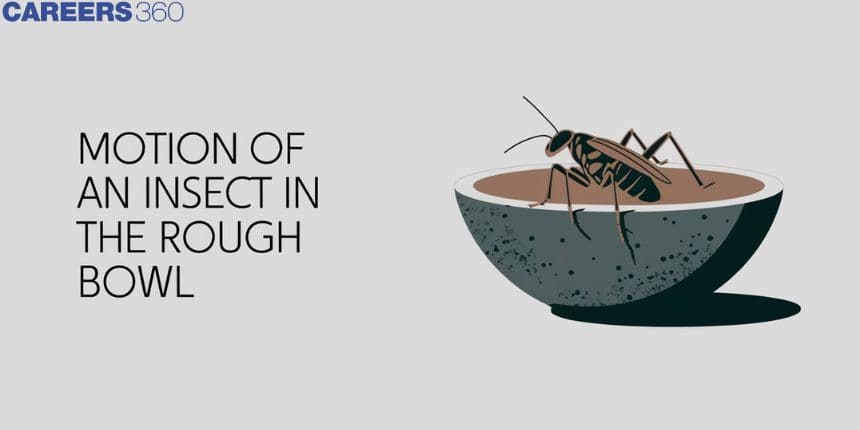Motion of an Insect in the Rough Bowl
Consider that you are observing a small insect that is attempting to get out of a shallow, rough bowl. The small insect crawls and, in the process, experiences the roughness of the surface, thus trying to climb out. Sometimes, it slips and goes backwards. Sometimes, it succeeds. This scenario is both interesting to observe and a great example of how motion and friction on various surfaces work. Its movements help you understand the different kinds of forces coming into play to affect motion on rugged surfaces.
In this article, we will cover the concept of Motion Of An Insect In The Rough Bowl. This concept falls under the broader category of law of motion which is a crucial chapter in Class 11 physics. It is not only essential for board exams but also for competitive exams like the Joint Entrance Examination (JEE Main), National Eligibility Entrance Test (NEET), and other entrance exams such as SRMJEE, BITSAT, WBJEE, BCECE and more. Over the last ten years of the JEE Main exam (from 2013 to 2023), a total of two questions have been asked on this concept. But no direct question in NEET from this concept.
This Story also Contains
- Motion Of An Insect In the Rough Bowl
- Solved ExampleBased On Motion Of An Insect In The Rough Bowl
- Summary

Motion Of An Insect In the Rough Bowl
As the insect crawls up, limiting friction force decreases and the component of weight along the surface (driving force) will decrease. Let's assume the insect can crawl up to height 'h' before it starts slipping. At that moment the frictional force will be limiting friction force as shown in the figure.

Let m=mass of the insect, r=radius of the bowl, μ= coefficient of friction for limiting condition at point A.
R=mgcosθ… (i) Limiting friction −fl=μR=μmgcosθfll=mgsinθ… (ii)
From equation (i) and (ii)-
mgsinθ=μmgcosθ
tanθ=μtan2θ=μ2
(r2−y2)y2=μ2y=r1+μ2r−h=r1+μ2 h=r[1+11+μ2]
Recommended Topic Video
Till now we have studied the concept of Motion Of An Insect In The Rough Bowl. Now we will see some of the solved examples for a better understanding of the above concept.
Solved ExampleBased On Motion Of An Insect In The Rough Bowl
Example 1: An insect crawls up a hemispherical surface very slowly (see the figure). The coefficient of friction between the insect and the surface is 1/3. If the line joining the centre of the hemispherical surface to the insect makes an angle θ with the vertical, the maximum possible value of θ is given by:

1) cot−13
2) tan−13
3) sec−13
4) cosec−13
Solution:
As the insect crawls up, limiting friction force decreases and the component of weight along the surface (driving force) will decrease. Let's assume the insect can crawl upto angle $\theta$ before it starts slipping. At that moment the frictional force will be limiting friction force as shown in the figure.

From fig,
R=mgcosθ Limiting friction −fl=μR=μmgcosθ… For equilibrium- fl=mgsinθ… (2) From equation (1) and (2)- mgcosθ=μmgcosθcotθ=1μ=3θ=cot−13
Hence, the answer is option (1).
Example 2: If the coefficient of friction between on insect and bowl is μ and the radius of the bowl is r. Find the maximum height to which the insect can crawl up in the bowl.
1) r1+μ2
(2) rμ1+μ2
3) r[1−11+μ2]
4) ru1−μ2
Solution:
Motion an insect in the rough bowl -
Till the component of its weight along with the bowl is balanced by limiting frictional force, then only the insect crawls up the bowl, up to a certain height h

R=mgcosθ......(I)
and
Fl=mgsinθ ...... (ii)
Dividing (ii) by (i)
tanθ=F1R=μ[ using Fl=μR]∴r2−y2y=μ or y=r1+μ2
So h=r−y=r[1−11+μ2],
∴h=r[1−11+μ2]
where,
h= height up to which insect can climb
m= mass of insect
r= radius of the bowl
μ= coefficient of friction
Example 3: An insect is at the bottom of a hemisphere ditch of radius 1 m. It crawls up the ditch but starts slipping after it is at height ' h ' from the bottom. If the coefficient of friction b/w the ground and the insect is 0.75. Then h is : (g=10 m/s2)
1) 0.6 m
2) 0.45 m
3) 0.2 m
4) 0.8 m
Solution:
Till the component of its weight along with the bowl is balanced by limiting frictional force, then only the insect crawls up the bowl, up to a certain height h

R=mgcosθ
(i) and
Fl=mgsinθ
Dividing (ii) by (i)
tanθ=FFR=μ[ using Fl=μR]∴r2−y2y=μ or y=r1+μ2
So h=r−y=r[1−11+μ2],
∴h=r[1−11+μ2]
h=r[1−11+μ2]=1[1−11+(34)2]=1(1−45)=15=0.2 m
Hence, the correct answer is option (2).
Example 4: A block of mass m is placed on a surface with a vertical cross-
section given by y=x36. If the coefficient of friction is 0.5 ,t he maximum height above the ground at which the block can be placed without slipping is :
1) 16m
2) 23m
3) 13m
4) 12m
Solution:
As we learnt in
mgSinθ=μmgCosθtanθ=μ⇒>y=x36dydx=x22=12x=1y=16m
Hence, the answer is the option (1).
Summary
In Short, the motion of an insect in a rough bowl is influenced by factors such as friction, gravity, and the bowl's curvature. The insect's path is determined by the balance between its own movement and the forces acting on it, often resulting in complex, non-linear trajectories. Understanding these dynamics can provide insights into the insect's behaviour and the physical principles at play.